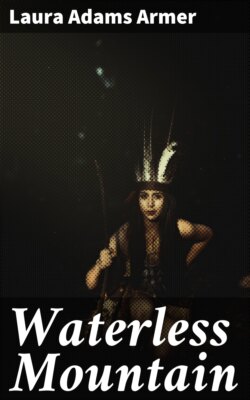Читать книгу Waterless Mountain - Laura Adams Armer - Страница 3
На сайте Литреса книга снята с продажи.
ОглавлениеFOREWORD
Table of Contents
N AUGUST 1924, my partner and I turned our two scraggly ponies and our treasured albino pack-horse loose in a corral at Oraibi and looked over the village. Hardly had we had time to buy a bottle of pop and roll a cigarette than we were informed that there was a lady artist in the schoolhouse, who had persuaded a Navaho medicine man to make a sacred sand painting for her and, contrary to the ceremonial laws, leave it undestroyed for people to look at. Incredulous, we went to see. The lady received us with some restraint, our aspect did not seem to charm her. Still, she admitted us to her temporary studio, and there was the sand painting, sure enough, complete even to the prayer-sticks around the edges, and many excellent pictures by herself to boot.
She grew more cordial after a while, and in talking with her about the Indians, we began to perceive the charm and sympathy which had won a medicine man to violate a dozen taboos for her. Finally she decided we were harmless. We invited her to our camp for a Navaho meal of goat’s ribs, and she, game lady, accepted. So we went and got ready.
We looked at ourselves as we had not in some weeks, and understood the coolness of our first reception—unshaven chins, the dust of the trail piled thick on filthy and tattered clothes, my partner’s golden hair turned a dull brown, we were the sorriest looking pair of tramps you ever saw. We got ourselves clean, Mrs. Armer came and shared our rather crude victuals, and friendship began.
Partly because of her paintings of the Navaho legends, in which the Indians saw an unusual insight and an expression of many things which they did not expect white people to understand, partly because she has been guided in her contacts by one of the wisest and most sympathetic of all the Navahos’ friends, and largely through her own personality, she has been able to come unusually close to these people in a very short time. Her knowledge of their real selves has enabled her to select a difficult theme for her book, the internal processes, the thoughts and feelings and growth of a Navaho boy who feels a vocation to become a medicine man. It is a daring subject for a white person to tackle, but within the limitations of a book for young people, Mrs. Armer has probably come as close to painting a true picture as anyone save a medicine man can do. Many readers will question the high religious ideas, the constant talk of beauty, the mysticism, that she ascribes to Younger Brother and his priestly Uncle; one can only say that, contrary to the general idea, many Indians are so.
February 1931
